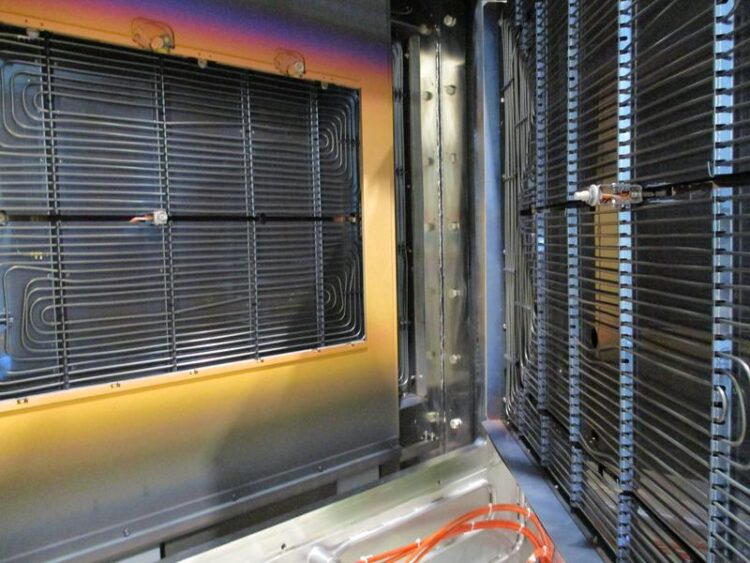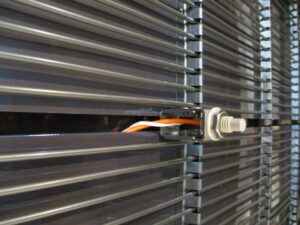HotSense – new thin-film measurement techniques for high-vacuum and high-temperature processes

Newly developed measurement setup with sensor measuring head for in-situ characterization of coating processes at high process temperatures
© Fraunhofer FEP
In cooperation with SURAGUS GmbH, the Fraunhofer FEP has succeeded in realizing non-contact in-situ measurements under high vacuum conditions at temperatures of up to 220°C within the HotSense project (grant number 100547507/4102) funded by the Saxon State Ministry of Economics, Labor and Transport (SMWA).
Thus, measurements of the sheet resistance or -conductivity, or the metal layer thickness can be carried out in close proximity to the process directly after hot layer deposition or layer modification processes by means of non-contact high-frequency eddy current measurement. Furthermore, the developed setup can be adopted for process characterization up to 450 to 600 ° Celsius.

© Fraunhofer FEP
Thin, functional conductive layers with adjustable properties are not always obvious, but occur in a wide range of applications. These include, for example, switchable or energy-efficient windows, various types of solar cells, batteries, semiconductor chips (ICs) as well as touch screens. With their adapted properties, the very thin functional layers are essential for the functionality, lifetime and performance of these applications. The coating processes for depositing such thin films usually take place in high vacuum and in case of transparent conductive layers under high process temperatures.
Annealing processes for the specific adjustment of coating and/or substrate properties also require several hundred degrees Celsius. Direct measurements of the sheet resistance are typically used for process control and stabilization. Previous measurement methods for non-contact electrical in-situ characterization of such vacuum coatings are only possible up to a temperature of 65°C, which prevents efficient plant operation. This limit has now been significantly extended so that in-situ coating characterization can now be carried out directly in the high-temperature process environment or even close to the process and without any sample contact.
Fraunhofer FEP has extensive experience and comprehensive know-how in the field of surface engineering for stationary and sheet-to-sheet as well as roll-to-roll processes. To ensure high quality and functionality of the customized coating stacks, characterization and monitoring of the process steps in-situ, i.e. during the coating processes, is necessary. Especially in vacuum processes, compatible real-time measurements – for example of sheet resistance – are challenging but necessary to enable contamination-free and reproducible results.
SURAGUS GmbH is a specialist for non-contact coating and material characterization by means of high-frequency eddy current sensor technology. The company, located in Dresden, employs approximately 50 people and is continuously expanding the fields of application for applied inductive measurement technology.
Development of new in-situ measurement methods for high process temperatures
The project HotSense funded by the Saxon State Ministry of Economics, Labor and Transport aims to close this gap. For this purpose, the project partners SURAGUS and Fraunhofer FEP investigated measurement methods for the non-contact in-situ characterization of the electrical resistance of thin films under high vacuum and high temperature requirements.
After two years of joint development, the researchers have succeeded in implementing the measurement method at elevated temperatures of up to 220°C, which means that coating characterization is also possible at elevated process temperatures.
The sheet resistance is measured in direct vicinity of the processes under vacuum conditions in order to give immediate feedback for coating processes and to avoid oxidation during annealing. In addition, the measuring head was significantly reduced in size in the test setup, which enables applications with limited installation space.
With this non-contact measurement method for monitoring heated coating or annealing processes, customers can optimize their processes, quality and the operating costs of equipment. This enables measurements in many other applications and plant types.
Application-oriented measurement setup with downsized sensor head
Project manager Thomas Preußner from Fraunhofer FEP explains: “Together, we created a measurement setup under conditions close to the application. Fraunhofer FEP was able to draw on its extensive knowledge of the resistance-temperature behavior of thin films up to 600°C. Using the results from the correlation between temperature and measurement signal, SURAGUS developed a novel measurement compensation algorithm ensuring precise resistivity values. We also supported the experimental setup with our knowledge of the influence of crystallization and phase changes of transparent conductive oxides (TCOs) during the annealing process.”
The developers at SURAGUS contributed extensive knowledge about the behavior of the measurement setup and the sensor. In the course of the developments, the sensor head for the characterization was redesigned and, with a size of approx. 12 × 40 mm², got significantly smaller. The entire measurement setup was tested and developed at the ILA 900 in-line sputtering system for coating flat substrates, under clean room conditions, at Fraunhofer FEP.
As a result, the new measurement setup could be investigated and characterized on a pilot scale. Metrological investigations were carried out on drift, signal strength, external sources of interference and the behavior of sensor, sample and temperature in relation to each other. Specifically, the resistance measurement range extends over three decades and exhibits a reproducibility < 2%. The solution aimed at here will cover five measurement decades from 0.001 to 100 Ohm/sq, which includes a metal thickness measurement range from a few nanometers to a few micrometers.
The first commercial systems are planned to be launched on the market by SURAGUS by the end of 2023. Together with SURAGUS, Fraunhofer FEP aims to further develop the existing technology to enable characterization at even higher temperatures. Both project partners are open for customer-specific investigations
The project results were presented at the 66th SVC TechCon 2023, May 8-11, 2023 in Washington D.C., USA, in conference presentations and at the Fraunhofer FEP booth.
About the HotSense project
Investigation of the measurement method for the contactless in-situ characterization of the electrical resistance of thin films under high vacuum and high temperature conditions (HotSense)
Funded by: Saxon State Ministry for Economy, Labor and Transport
Funding reference: 100547507/4102
Duration: 01.06.2021 – 31.11.2022
Press contact:
Ms. Annett Arnold
Fraunhofer Institute for Organic Electronics, Electron Beam and Plasma Technology FEP
Phone +49 351 2586 333 | presse@fep.fraunhofer.de
Winterbergstraße 28 | 01277 Dresden | Germany | www.fep.fraunhofer.de
Weitere Informationen:
Media Contact
All latest news from the category: Power and Electrical Engineering
This topic covers issues related to energy generation, conversion, transportation and consumption and how the industry is addressing the challenge of energy efficiency in general.
innovations-report provides in-depth and informative reports and articles on subjects ranging from wind energy, fuel cell technology, solar energy, geothermal energy, petroleum, gas, nuclear engineering, alternative energy and energy efficiency to fusion, hydrogen and superconductor technologies.
Newest articles

Properties of new materials for microchips
… can now be measured well. Reseachers of Delft University of Technology demonstrated measuring performance properties of ultrathin silicon membranes. Making ever smaller and more powerful chips requires new ultrathin…

Floating solar’s potential
… to support sustainable development by addressing climate, water, and energy goals holistically. A new study published this week in Nature Energy raises the potential for floating solar photovoltaics (FPV)…

Skyrmions move at record speeds
… a step towards the computing of the future. An international research team led by scientists from the CNRS1 has discovered that the magnetic nanobubbles2 known as skyrmions can be…





















